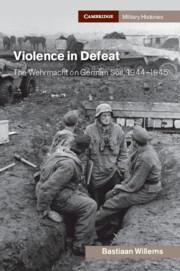Book contents
- Violence in Defeat
- Cambridge Military Histories
- Violence in Defeat
- Copyright page
- Contents
- Figures
- Maps
- Tables
- Acknowledgements
- Chronology of Events
- Abbreviations
- Introduction
- 1 Regionality and Total War in East Prussia
- 2 Eastern Front Battles on German Soil
- 3 The City As a Fortress Community
- 4 Redefining Königsberg: Historical Continuity in Practice
- 5 The Evacuation of East Prussia
- 6 Königsberg as a Community of Violence
- Conclusion
- Appendices
- Bibliography
- Index
4 - Redefining Königsberg: Historical Continuity in Practice
Published online by Cambridge University Press: 12 February 2021
- Violence in Defeat
- Cambridge Military Histories
- Violence in Defeat
- Copyright page
- Contents
- Figures
- Maps
- Tables
- Acknowledgements
- Chronology of Events
- Abbreviations
- Introduction
- 1 Regionality and Total War in East Prussia
- 2 Eastern Front Battles on German Soil
- 3 The City As a Fortress Community
- 4 Redefining Königsberg: Historical Continuity in Practice
- 5 The Evacuation of East Prussia
- 6 Königsberg as a Community of Violence
- Conclusion
- Appendices
- Bibliography
- Index
Summary
This chapter assesses the emergent mindset and the city’s insular nature by providing an analysis of the propaganda created in Königsberg during its siege. As the idea of Volksgemeinschaft steadily lost its appeal, propagandists struggled to convey their message to the fortress’s population. By drawing attention to the efforts of local propagandists, this chapter examines the impact of the Wehrmacht ‘on the ground’, and discusses the need to forge a Kampfgemeinschaft, based on Königsberg’s ‘battle’ rather than on Germany’s ‘struggle’. Rather than encouraging the population to leave the city, the fortress command instead propagated a false sense of safety. An assessment of the themes portrayed in local media reveals how, in a fractured Germany, local authorities presented their message and how they sought to link it to the larger regional picture of events. A martial narrative came to dominate Königsberg’s propaganda while the unfolding events were consistently explained by drawing parallels to the city’s Prussian past, offering an alternative to the National Socialist rhetoric. The population’s reluctance to leave the city until the very end is a sombre testament to the propagandists’ success in downplaying the dangers to which all were exposed.
Keywords
- Type
- Chapter
- Information
- Violence in DefeatThe Wehrmacht on German Soil, 1944–1945, pp. 158 - 187Publisher: Cambridge University PressPrint publication year: 2021

